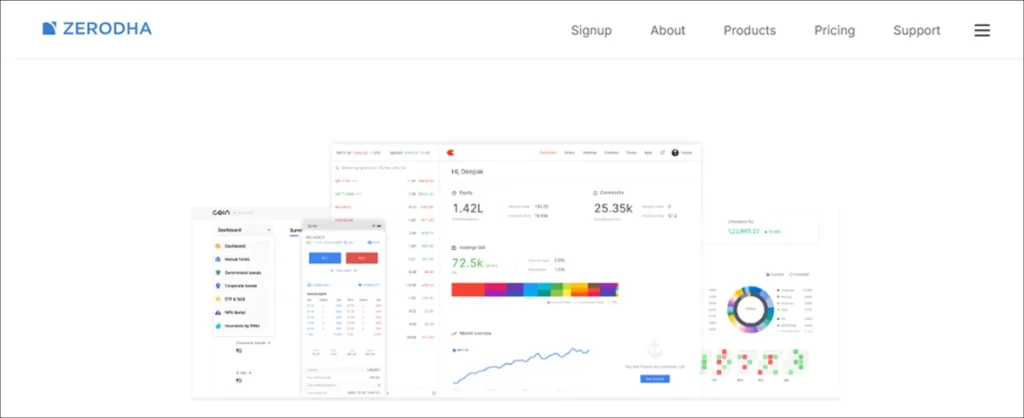Necessary Always Active
Necessary cookies are required to enable the basic features of this site, such as providing secure log-in or adjusting your consent preferences. These cookies do not store any personally identifiable data.
|
||||||
|
||||||
|
||||||
|

In the last several years, Indians’ investing habits have undergone a major shift. With online financial services rising and more people realizing the benefits of wealth creation, individuals are choosing to handle their investments online. Investing in stocks once required significant efforts and specialized skills, but that is no longer the case. Now, Zerodha and Groww allow users to start investing in the stock market quickly, simply by using their phones and having a bank account.
However, there are additional elements investors check before investing. Now that there are so many online brokers and investment apps available due to the fintech revolution, the hard part is picking one that fits your personal goals, skill level, and how well you handle market tools. When it comes to low-cost platforms, Zerodha and Groww are usually the first names to be mentioned due to how much of Indian customer trusts them.
This blog compares the different aspects of these platforms, such as their usability, available tools, features, and money involved. If you are a first-timer or an expert, this comparison will help you pick which option will work better for you when you invest.
Let’s begin with what each platform is known for.
At the core, Zerodha is the go-to for traders who want control and insights, while Groww is a hit among those who value ease and long-term investing.
Both platforms allow paperless onboarding, making it simple to open a demat and trading account from your phone or laptop.
If your goal is to just start investing without friction, Groww’s speed is unbeatable. But if you’re looking for a powerful trading setup, Zerodha’s diligence pays off.
When it comes to usability, both platforms cater to distinct audiences.
Groww takes a minimalist approach. Its mobile app and web interface are streamlined, with neatly categorized sections for mutual funds, stocks, and portfolios. A new investor can figure out how to place an order or review holdings with zero external help.

Zerodha’s Kite, meanwhile, is built for depth. The layout is more information-heavy, with customizable widgets, advanced charting tools, and data overlays. It’s not immediately intuitive if you’re just starting, but once you get the hang of it, the platform becomes a power user’s playground.

In short, while Groww is user friendly, Zerodha focuses on functionality. Choose based on whether you want a light experience or a detailed one.
Your platform choice should reflect what kind of investor you are.
Zerodha offers a comprehensive suite of investment avenues:
Groww, on the other hand, focuses on a leaner offering:
If you’re planning to explore market depth, trade derivatives, or diversify into commodities or bonds, Zerodha is your platform. If your investing is centered around equity and mutual funds for long-term wealth creation, Groww covers all you need.
Let’s talk numbers, because they matter—especially if you’re trading frequently.
Zerodha’s model is simple and predictable:
Groww, while offering free equity delivery and mutual fund investments, applies similar intraday/F&O charges:
At face value, both offer low-cost investing. The absence of AMC on Groww is a plus for low-frequency investors, while Zerodha’s pricing works better for high-volume traders due to its precise fee structure.
Both offer free equity delivery on most plans and a flat fee on active trades. The main difference shows up for frequent traders and for segments beyond basic delivery. Zerodha’s flat fee model is built for strategy testing and high turnover days. Groww keeps costs predictable for long term investors who place fewer orders.
One of the most important differences lies in the depth of trading tools and resources offered.
Zerodha is unmatched in this department. It gives you access to:
Partner tools like Sensibull (options trading), Smallcase (theme-based investing), and TickerTape (fundamental analysis)
Groww provides only the essentials. It offers:
Zerodha’s ecosystem is built for users who want to go deep into markets, build strategies, and take a hands-on approach. Groww is best for those who want to invest without digging too far into analytics.
For mutual funds and SIP, both apps support direct plans with simple setups. Groww keeps the path from discovery to purchase very short, which is helpful when starting a new SIP. Zerodha’s strength is portfolio level control and the ability to keep funds and stock activity in a single place with deeper reporting.
When it comes to support, both platforms take different routes.
Groww has built a reputation for quick in-app support. Most queries are resolved through live chat, and the interface guides you to FAQs based on your actions. For newer investors who need quick reassurance, this model works well.
Zerodha, with its larger user base, operates a more structured support system. It offers:
So, if you prefer fast replies and mobile-based help, Groww wins. If you’re looking for detailed documentation and community-driven discussions, Zerodha is more reliable.
Both use two factor sign in and standard encryption. Zerodha’s workflow favors advanced permissions and account level checks before unlocking new segments. Groww focuses on a quick sign in and guided actions inside the app. Either path is safe for regular use. The better fit comes down to how much control is needed and how quickly orders must be placed.
Both platforms operate under strict SEBI regulations and ensure industry-standard security protocols. Here’s what they have in common:
Zerodha has the benefit of a longer market presence and a larger user base, which naturally builds more institutional trust. Groww, despite being newer, has been consistent in maintaining compliance and has won user confidence steadily.
There’s no significant gap here—you can trust either platform with your capital.
To make it easier, here’s a breakdown based on your investing behavior:
Choose for Groww if you:
Prefer investing from your phone without too many steps
Choosing between Zerodha and Groww isn’t a matter of one being better than the other—it’s about alignment. Your ideal platform should match your investment goals, learning curve, and the kind of experience you want.
If you’re just getting started, Groww provides a gentle, intuitive entry point. For those aiming to actively trade or grow into professional-level tools, Zerodha offers everything you need and more.
Still unsure? Try both. You don’t need to go all in—create small positions, test each platform’s feel, and track which one makes you more confident. After all, the best investing platform isn’t just about features; it’s about how well it empowers you to make smarter financial decisions.
Which is better, Zerodha or Groww in 2025
It depends on how the account will be used. Zerodha suits active traders who want advanced tools and control across segments. Groww suits investors who want a clean way to buy equity delivery and direct mutual funds with very little setup time.What are the charges on Zerodha and Groww
Both offer free equity delivery on most plans and a flat fee per executed order for intraday and F and O. The total cost for an investor depends on how many orders are placed and which segments are used in a typical month.Which is better for mutual funds and SIP
Both support direct plans. Groww makes discovery and purchase very simple. Zerodha keeps funds and stock activity in one place with robust reporting for people who like to see all activity together.Which is safer for beginners
Both follow standard rules and security checks. Beginners who prefer a guided mobile experience tend to find Groww easier. Users who want advanced controls and education resources often pick Zerodha.
Sign up to receive our newsletter featuring the latest tech trends, in-depth articles, and exclusive insights. Stay ahead of the curve!